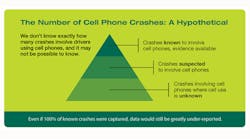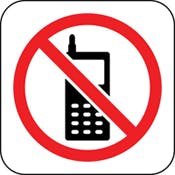A review of fatal car crashes that involved driver cell phone use suggests that cell phone use may be underreported or inconsistently reported, according to the National Safety Council (NSC). NSC President and CEO Janet Froetscher said the number of crashes involving cell phone use and distraction likely is “much greater” than current reporting indicates due to a variety of complicating factors.
The report, “Crashes Involving Cell Phones: Challenges of Collecting and Reporting Reliable Crash Data,” analyzed national statistics on 180 fatal car crashes that took place from 2009 to 2011 and involved cell phone use. Of these fatal crashes in 2011, only 52 percent were coded in the national data as involving cell phone use. And in some cases, cell phone use involvement in crashes may be impossible to determine, such as a driver texting or emailing who dies in a crash without witnesses.
In 2012, highway fatalities increased for the first time in 7 years. Based on risk and prevalence of cell phone use, as reported by research and the National Highway Traffic Safety Administration (NHTSA), NSC estimates 25 percent of all crashes involve cell phone use.
The report, meanwhile, points out that “there is no reliable method to accurately determine how many crashes involve cell phone use; therefore, it is impossible to know the true scope of the problem.”
Reporting Challenges
Verifying whether cell phone use was a factor in a crash can be challenging, according to the report. For example, police officers often must rely on drivers to admit cell phone use; witnesses memories and statements may be inaccurate; police may not investigate cell phone use if it’s not in their jurisdiction or if a more obvious violation is involved; cell phone records can be difficult to obtain; and cell phone data must align with the exact moment of the crash, which may not be known.
Reporting also appears to be inconsistent among different states. In 2011, Tennessee reported 93 fatal crashes that involved cell phone use, while New York, a state with a much larger population, reported only one. Texas reported 40, but its neighboring state Louisiana reported none.
“The public should be aware that cell phone-involved fatal crashes are not accurately being reported,” said Bill Windsor, associate vice president of consumer safety at Nationwide Mutual Insurance Co., which partially funded the study. “These statistics influence national prevention priorities, funding decisions, media attention, legislation and policy, even vehicle and roadway engineering. There are wide-ranging, negative ramifications to safety if a fatal crash factor is substantially under-reported, as appears to be the case of cell phone use in crashes.”
NSC offers the following recommendations:
- National distracted driving and cell phone crash statistics should be described as the minimum number collected and reported by a process full of limitations.
- Policy makers should assume that cell phone involvement in crashes is substantially greater than shown by crash statistics when making policy decisions.
- NHTSA should conduct a feasibility study to determine if an under-reporting correction is possible for cell phone use, similar to the imputed data on blood alcohol concentration (BAC) for drivers who were not tested for BAC or whose test results are unknown.
Learn more by downloading the report (PDF) or visiting NSC’s distracted driving site.


